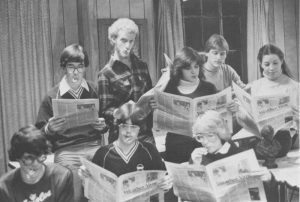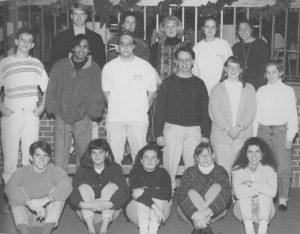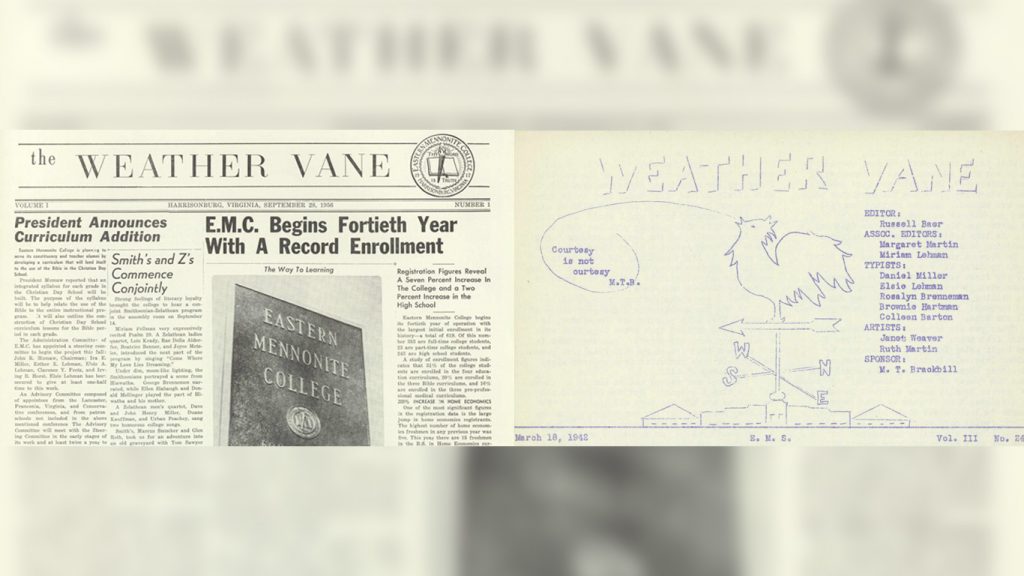From the first “Purple Press” issue printed as a mimeographed, letter-sized paper in 1939 to the Weather Vane online, the EMU student newspaper has been a vessel of student expression for not only staff reporters, but for the entire campus community.
In his 50-year history of the college, Hubert Pellman ’38 described the Weather Vane as an “intimate, chatty, newsy, breezy little student paper” that “started to let readers know how the winds were blowing on campus.”

The first issue claimed to “offer a complete cross section of school life” and was an 8-inch-by-11-inch sheet with paragraphs showcasing different elements of the school day, helpful tips about room inspection, a short interview with a chemistry professor, quick words of advice from the apparently wise J. Irvin Lehman. Each paragraph was titled with some sort of weather related phenomenon, such as “Sunbeams” or “How the Wind Blows.” By the time the third issue was published in November, the Weather Vane was a two-page pamphlet that included multi-paragraph stories.
‘Purple Press’ upgrades
In 1956, the “Purple Press” changed to newspaper format in the fall as it merged with another student publication, The Journal, which was sent to alumni, donors and students. The Weather Vane was restarted at Volume One. Pellman argues this change was to “achieve the advantages of economy, wider and fresher news coverage, and larger circulation.” The last run of the mimeographed version of the Weather Vane printed on May 21, 1956 closed with the words of then-editor Paul M. Schrock ’57; “Today she dies, but in her death struggle, she gives birth to a new publication: a different, bigger and better Weather Vane.”

That fall, the paper’s new format boasted five columns of newsprint and halftone photographs. Staff consisted of a news editor, a dozen campus reporters, a feature editor, a creative writing collector, a pollster, an alumni editor, a copy editor, a typist, a proof-reader, two photographers and a business manager. Professor Irvin B. Horst was the faculty sponsor.
By 1960, a one-year subscription to the Weather Vane cost a whopping $2. The paper was printed 16 times a year and included a literary arts section and Eastern Mennonite High School’s newspaper, “The Windsock,” on the back page of each issue. A “Who’s Who” feature introduced students of the college to the student body, and most issues included marriage engagement announcements from the weeks preceding publishing.
1961 brought some formatting changes. The Windsock separated from the Weather Vane, and the classic old-time newspaper masthead font was abandoned for a cleaner, simpler font.

Mary Lou Brubaker ’62, the paper’s first graphic artist, designed the first infographic, a pie-chart illustrating funds raised by the YCPA, in March 1962. The first editorial cartoon, drawn by Irvin B. Horst, followed later that year in the Oct. 5 issue accompanying the column, “Will Rome Council Promote Church Unity or Tradition?”
Administrative review provokes ire
Staffers and editors from the early ‘60s remember the red pen of Lester Shank ’49, President John Mumaw’s chief assistant. After the paper’s layout was complete on Monday mornings, editors submitted their work to Shank for prior review.
“Shank, on behalf of Mumaw, held veto power over the content of the paper, although it was used infrequently,” said Ken Eshleman ’64, a four-year staffer who held positions of sports editor, managing editor and editor-in-chief.
Eshleman recalls two situations in particular where the red pen vetoed his proposed content. The first story involved the dunking of a newly engaged male student in a farmer’s pond, a practice that administration did not condone, but tolerated as long as it occurred off campus. Staff photographer Elmer Kennel ’64 was sent to record the event, and another student wrote a feature article on the tradition.
“Because of the great human interest, we placed the picture of the young man in mid-air in his pajamas and the article on page one. On Monday morning, Shank objected to both the article and picture because he feared adverse constituent reaction,” Eshleman said. “After our protest, Shank and Mumaw allowed us to print the article on page three, but forbade use of the picture. We complained to no avail, but did post the photo on the Opinion Board in the Administration Building, along with a letter denouncing censorship of the press.”
Kennel also caused issues when he captured a picture of male athletes in a relay where their pants rose a few inches above their knees.
“When the Monday morning censor objected, Elmer Kennel took the photo to the darkroom and cleverly added a white extension to [Paul] Yoder’s white cutoffs. We were then permitted to print the doctored version of the picture,” Eshleman said. The picture was also printed in the ‘64 Shenandoah yearbook.
Jim Bishop ‘67 recalls the censorship also led to the publishing of an underground newspaper called the Piranha that covered anything from satire columns to the war in Vietnam, race relations, and the conservative emphasis on campus. Following this protest, the administration dropped all prior review.
Through the years, Weather Vane editors continued to protest administrative policy. The 1969 editorial “Keep off the Grass” [Jan. 24] questions administrative policy on male students’ entering women’s housing as they pleased, but the reverse situation was completely prohibited.
More changes
The early 1970’s brought the first comic strip to the Weather Vane. “Mennofreak” illustrated by Marlise Horst ’73 followed a hippie college student through existential crisis and self discovery. The first Weather Vane poll, which questioned students about WEMC, the college’s radio station, was published in 1972.
Steve Shenk ‘73 recalls the Weather Vane office resided in the upper floors of the old Administration Building. Shenk worked under editor-in-chief John Otto, a former news editor himself.
“I respected him a lot,” Shenk said, who went on to be a wordsmith himself, working in editing and writing. For 11 years, he was EMU’s director of marketing.
As Marla Longenecker ‘75 remembers there is nothing like the excitement she felt seeing her first article in print on Sept. 24, 1971. After that, she claims she was “off and running as a novice reporter,” and “eagerly accepted each assignment that fall.”
In spring of 1973, Longenecker saw Weather Vane breaking news coverage at its finest, beating the college’s professional publication to a story about David Hooley and his efforts to build a personal computer.

“One afternoon, Jim Bishop, the new director of media relations, bounded into the Weather Vane office to tell me that we had scooped him on a story in the April 6 issue,” Longenecker said. “I was quite pleased and proud that we had beaten Jim to this story.”
Once the articles were written and the paper was laid out, editors traversed to Dayton or later Elkton to print the paper. Gretchen Maust ‘73 was one of many Weather Vane editors that made two journeys to an outside printer per issue; the first with the paste-ups after all formatting was completed, and the second for final proofing.
“It was a big deal to make changes and old Mr. Ruebush did not take kindly to anything last minute. In the two years I went to Dayton…Though a basically nice person, I don’t think Mr. Ruebush smiled at me one time,” Maust said.
From paste-ups to digital publishing
During the mid-eighties, the Weather Vane offices took up residence in the basement of the Humanities Hall, complete with a darkroom, but no computers yet.

Les Horning ’86 fondly remembers a block of wood with a chiding inscription, for our purposes here paraphrased as, “stop the complaining.”
“I loved layout time…blue pencils and all,” Horning said, “No matter how late we worked into the night.”
Gloria Rhodes ’85 remembers “lots of White-Out, rulers, and tape” were used during the layout stage of publication. Rhodes recalls driving to Burkholders on Va. 33 to get the copy strips, the backs covered with wax. The editor had one shot with typesetting.
“I do remember adding in commas and periods with pens,” Rhodes said. “And if we accidentally cut a word or portion of a word, we had to creatively recreate it.”
She continues: “After we had the waxed strips pasted down, we had to drive the galley sheets to Elkton to be printed at X-High Graphics. And then someone had to go back to Elkton to pick up the papers to be distributed. We were always working on deadline, knowing that we had a 30-minute drive to Elkton after we were finished pasting up.”

Just one year after Rhodes graduated, in 1986, the Weather Vane switched from typesetting with galley strips to desktop computer publishing.
“We had a brand-new Macintosh 512ke with an internal and external floppy disk drive,” Paul Groff ’90 said. “The first issues looked pretty ragged as we figured out the layout program, MacPublisher. We took the issue on floppy disk to Paul Souder in Linville who had one of the earliest Apple laser printers. That’s where we printed it out, taped the 8.5 by 11-inch sheets together, and sent to the printer.”
Groff later purchased that very same computer for personal use for a few years. He still owns the computer today.

“A couple years ago I turned it on and it still worked, though the already tiny screen was squashed to half size,” Groff said.
By 1989, faculty advisor Omar Eby ’57 was pleading for less verbiage. Weather Vane staffers’ fondness for lengthy personal columns was not shared by Eby. An excerpt from Eby’s open letter to present and future Weather Vane editors put the issue eloquently.
“Let it be one scant column per issue I beg of thee! No? Must it be eight pages? For whom? Hardly even for first-term freshman. Hardly for Ad Majoreum Del Gloriam! Hardly for creative release. Not everything written needs to be printed,” Eby said.
In 1996, then-editor Peter Kraybill ’97 shifted the Weather Vane from film photography to digital. Kraybill also put a drawing of the EMU bird in the masthead.
Critical voice continues
Even into the turn of the century, editors often used pages to creatively showcase their discontent with campus decisions. Editor Katrina Wert and assistant editor Tim Swartzendruber, both 1995 graduates, ran blank sports pages before the construction of the University Commons.

“We were convinced that the arts were being intentionally overlooked,” Swartzendruber said. “Under-informed move, in hindsight, because we had no real understanding of university fundraising and strategic planning for capital projects. Classic undergraduate idealists we were.”
In 2000, Micah Shristi ’00 recalls that when he and Bethany Spicher ’00 were “the highly principled editors” of the Weather Vane, the pair turned down a full-page ad that would have run every week for the entire semester on the grounds that the client was not a local business.
Lessons learned

For many alumni, writing for the Weather Vane has left an impact no other student organization or college experience could have delivered. Kraybill’s team-building skills have stuck with him through the present. He is now a partner with Gibbel Kraybill and Hess in Lancaster, Pennsylvania.
“It was great training in getting things done cooperatively with a group effort – a skill applicable to many areas of life. Based on the publication schedule, we regularly went nearly one night per week with almost no sleep, driving the printer’s proof copy to the printer at about 5 am. I was grateful for hardworking colleagues, and because we spent so much time together – people who love to have fun!” Kraybill said.
Longenecker opted to appreciate the people who create all words.
“I learned how to work with a variety of personalities from start to finish on a goal, and to take responsibility for the completion of a project. I learned how to listen and observe, how to talk to people and how to write their stories to share with the campus by way of the newspaper. I learned about what mattered to the members of that community,” Longenecker said.
Bishop credits his four years’ involvement on the Weather Vane staff with providing some of the best “on-the-job” experience for an eventual career in journalism that spanned 44 years. “The Bishop’s Mantle,” a column he wrote senior year at EMU, inspired a Saturday column in the Daily News-Record from 1990 until his retirement in 2011.
And there were of course fond memories to savor during the stressful publication cycle.
Miriam Housman ’53 distinctly remembers a sweet, stress-free moment, offered via letter from her home in Lititz, Pennsylvania: “Someone had a car—went to town—brought us soft ice cream. No spoons. I do remember … ‘slurping’ ice cream from a ruler.”
All past issues of the Weather Vane are digitized online and available for review, searchable by year and subject. Browse the collection here.
